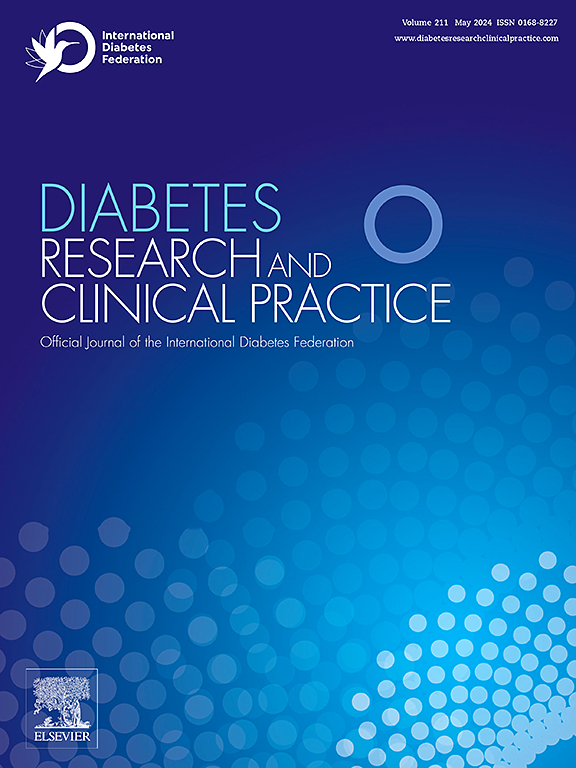应用负荷后1小时血糖诊断标准显示潜在MASLD的高进展风险。
IF 6.1
3区 医学
Q1 ENDOCRINOLOGY & METABOLISM
引用次数: 0
摘要
背景:最近,与常规血糖指标相比,1 h PG值≥ 8.6 mmol/L能更灵敏地预测与糖尿病相关的长期心血管并发症,国际糖尿病联盟立场声明建议将其作为糖尿病的附加诊断标准。然而,它在 MASLD 中的价值仍不确定:方法:对2009年6月至2024年5月期间连续接受脂肪肝影像学评估和75克口服葡萄糖耐量试验的患者进行回顾性研究,其中包括1154名MASLD患者、161名符合非酒精性脂肪肝诊断标准但不符合MASLD诊断标准的患者(NAFLD-non-MASLD)和1026名非脂肪肝患者:MASLD或NAFLD-non-MASLD患者的1-h PG水平高于非脂肪肝患者(P1-h PG≥ 8.6 mmol/L的非酒精性脂肪肝-非MASLD患者仍面临不良临床结局的高风险。这些发现支持将 1-h PG ≥ 8.6 mmol/L 作为代谢功能障碍定义的一个组成部分。本文章由计算机程序翻译,如有差异,请以英文原文为准。
Applying 1-hour postload plasma glucose diagnostic criteria reveals high Progressive Risks of potential MASLD
Background
Recently, a 1-h PG value of ≥ 8.6 mmol/L, a more sensitive predictor of diabetes mellitus-related long-term cardiovascular complications than routine glucose markers, has been recommended as an additional diagnostic criterion for diabetes in the International Diabetes Federation Position Statement. However, its value in MASLD remains uncertain.
Methods
Consecutive participants with imaging assessments of fatty liver and a 75-g oral glucose tolerance test, including 1154 participants with MASLD, 161 fulfilling the nonalcoholic fatty liver disease but not the MASLD diagnostic criteria (NAFLD-non-MASLD) and 1026 subjects with non-fatty liver, were retrospectively enrolled from June 2009 to May 2024.
Results
Patients with MASLD or NAFLD-non-MASLD had higher 1-h PG levels than those with non-fatty liver (p < 0.001). In patients with MASLD or NAFLD-non-MASLD, 1-h PG ≥ 8.6 mmol/L was associated with the risk of moderate-to-severe steatosis (p < 0.001), ALT elevation (p < 0.001), advanced fibrosis (p = 0.03), and cardiovascular diseases (p < 0.001). Furthermore, NAFLD-non-MASLD patients with 1-h PG ≥ 8.6 mmol/L showed a higher prevalence of advanced fibrosis than MASLD patients with or without 1-h PG ≥ 8.6 mmol/L (p < 0.05).
Conclusions
NAFLD-non-MASLD patients with 1-h PG ≥ 8.6 mmol/L are still at high risk of poor clinical outcomes. These findings support including 1-h PG ≥ 8.6 mmol/L as a component of the metabolic dysfunction definition.
求助全文
通过发布文献求助,成功后即可免费获取论文全文。
去求助
来源期刊

Diabetes research and clinical practice
医学-内分泌学与代谢
CiteScore
10.30
自引率
3.90%
发文量
862
审稿时长
32 days
期刊介绍:
Diabetes Research and Clinical Practice is an international journal for health-care providers and clinically oriented researchers that publishes high-quality original research articles and expert reviews in diabetes and related areas. The role of the journal is to provide a venue for dissemination of knowledge and discussion of topics related to diabetes clinical research and patient care. Topics of focus include translational science, genetics, immunology, nutrition, psychosocial research, epidemiology, prevention, socio-economic research, complications, new treatments, technologies and therapy.
 求助内容:
求助内容: 应助结果提醒方式:
应助结果提醒方式:


